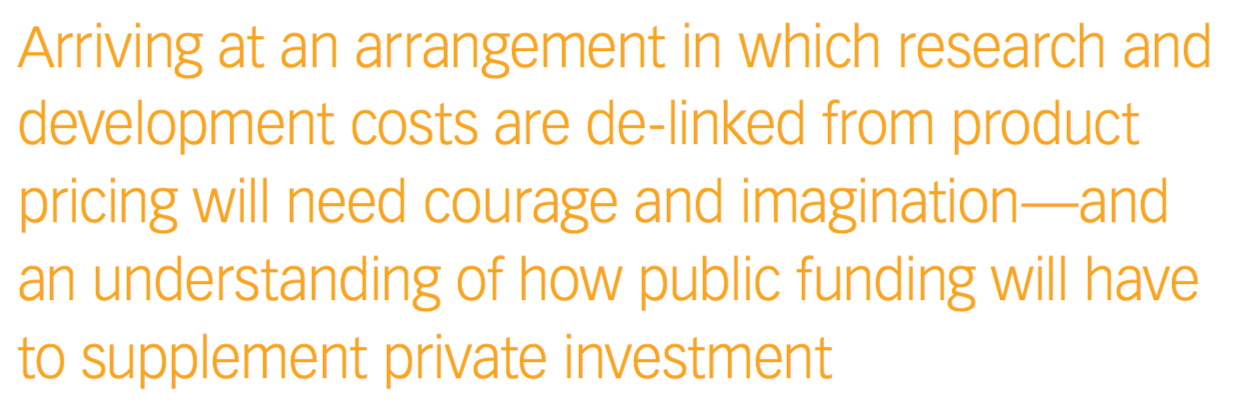R&D Model Mixes Compassion, Calculation
Pharmaceutical Executive
Altruism and self-interest are at the heart of European thinking on neglected diseases.
Of course everyone cares, and of course plenty gets done to tackle the problem-but the result is still alarming, and over the long term, alarming for the rich countries of Europe and the rest of the developed world. Tools are needed-many tools, and better tools than the current ones-to diagnose, prevent, and treat poverty-related and neglected diseases, such as HIV/AIDS, malaria, tuberculosis, sleeping sickness, and worm and parasitic infections. These diseases cause more than 6.5 million deaths in low- and middle-income countries every year, and are responsible for more than 300 million disability-adjusted life years there. Increasingly, however, the failures in developing treatments for these diseases is perceived as a demonstration of the failure of the development model that richer countries have depended on until now, and which may also prove deficient in the face of evolving challenges.
Committed to cause
Plenty is being done for poverty-related and neglected diseases. The US is way ahead in terms of funding research-accounting for nearly half of the world’s total public investment. A long way behind is the UK, which puts in less than 4% of the total, just pipping the EU into third place with a little more than 3%-although if the EU and its member states are taken together, the aggregate investment amounts to a slightly more credible 15% of the world total. The EU has made explicit commitments, based largely on humanitarian principles, to step up to the problem. As far back as 2010, the Council of the European Union resolved to promote “effective and fair financing of research that benefits the health of all,” and to focus on those interventions with the “biggest impact on public health.” And since then it has pumped more than a billion dollars into supporting research specifically oriented towards these diseases.
The EU has recently expanded its Africa-focused clinical trials program, EDCTP2, with an emphasis on reinforcing Africa’s own science base and on boosting local clinical research expertise. Bringing countries together to reduce duplication and fragmentation helps get the best value of available resources for expensive clinical trials, it says.
In March, the EU Commissioner for International Cooperation and Development Neven Mimica announced increased support-of well over half-a-billion dollars-to the Global Fund that supports research into these diseases. “One of the lessons learnt after the Ebola outbreak in West Africa is the clear need to strengthen health systems in developing countries, so that infectious diseases can be controlled for good,” he said at the time, calling on others to raise their contributions, too.
Numbers crunch
As Mimica’s remarks suggest, the EU’s altruism is, unsurprisingly, tinged, too, with a degree of self-interest. The emergence of new diseases and the increased mobility in a globalized world are an obvious threat to what had become regarded as the relative sanctuary of the developed world.
The recent waves of migration into Europe have underlined that challenge, and although the direct health impact has so far been minimal compared to the broader human tragedy of so many displaced people, the risk of disease transmission is being taken seriously. The most recent meeting of the EU’s forum on global health policy was devoted entirely to “health and migration,” with presentations from the European Commission, Oxfam, the International Organization for Migration, Medecins du Monde and the Red Cross.
The bigger implication of the challenge that these diseases presents, however, is becoming as valid for richer countries, too: how far the underlying challenge of paying for medicines development can be met. The limited commercial market for health technologies to address poverty-related and neglected diseases makes their research and development almost totally reliant on public funding. Until now, that is not a difficulty that has faced drug developers in the industrialized countries. But the fragmentation of therapeutic approaches as personalized medicine gathers pace is starting to present a similar dilemma for drug firms creating products for richer countries. As cancer treatments become increasingly targeted to subpopulations, the expectation of financial returns from sales can no longer be so confident-and this at a time when the costs of development have never been so high, and the strains on health budgets to pay for new drugs have never been so acute.
Already, studies suggest that as many as two-thirds of all new drugs fail to meet pre-launch consensus expectations for their first year on the market-and drugs that fall short then continue to fall short for the following two years. According to Impact of Incorrect Forecasts on New Product Launches, a new study from ORC International, Sanofi and Regeneron set the price for their colorectal cancer drug, Zaltrap, at $11,063 per patient per month, but the company was forced to cut the price in half when oncologists at Memorial Sloan Kettering Cancer Center refused to prescribe Zaltrap because cheaper alternatives already existed.
The more general statements of concern from drug manufacturers and their associations, in the US and in Europe, continue to grow louder by the month. A report published in March by the European Commission, aimed at helping to cut through the difficulties facing European countries in controlling their burgeoning drug budgets, was met by open hostility from drug firms critical of what they said was a failure to recognize the underlying challenges of funding innovation.
And as if cracks were not already appearing in the business model for drug development for the developed world, along comes AMR to drive the point home still more keenly. Antimicrobial resistance has exposed not only the lack of new products, but also the lack of incentives for the development of new products. The EU has, like many other countries and regions, started to accept the reality of the threat of uncontrolled and uncontrollable infectious disease, but most of the response to date has been in belated attempts to rein in slack prescribing culture and abuse in stock-rearing. The EU’s working party on public health has started to prepare draft conclusions which may be adopted at the EU Health Council in June, and the European Parliament voted through updates to veterinary medicines regulations.
Less is more
What is really needed is strategic thinking on new approaches to funding research in a context where the most successful products that emerge will be used as little, rather than as much, as possible. For the developed world, this is a real and unprecedented challenge, a departure from the hitherto sacrosanct principle of payment for volume sales. Arriving at an

arrangement in which research and development costs are de-linked from product pricing will need courage and imagination-and an understanding of how public funding will have to supplement private investment. That, too, will require adjustment to many of the accepted notions of intellectual property-now under determined challenge from many influential campaigners who see patents as an obstacle to new thinking about drug development and drug access, as the March meeting of the United Nations’ High Level Panel on Access to Medicines in London graphically demonstrated.
Think inward, too
A new-and critical-report on EU funding of poverty-related and neglected diseases concludes that to fill the evident gaps, the EU should develop “a comprehensive R&D funding strategy with clear objectives and an implementation plan, focused on delivering appropriate and accessible new health technologies to achieve the EU’s global health aims.”
It may be right. But also, in the tradition of “Physician, health thyself,” the EU is equally in need of a comprehensive R&D funding strategy to ensure the continued development of its aims for health in Europe, too.
Reflector is Pharmaceutical Executive’s correspondent in Brussels

Addressing Disparities in Psoriasis Trials: Takeda's Strategies for Inclusivity in Clinical Research
April 14th 2025LaShell Robinson, Head of Global Feasibility and Trial Equity at Takeda, speaks about the company's strategies to engage patients in underrepresented populations in its phase III psoriasis trials.
Beyond the Prescription: Pharma's Role in Digital Health Conversations
April 1st 2025Join us for an insightful conversation with Jennifer Harakal, Head of Regulatory Affairs at Canopy Life Sciences, as we unpack the evolving intersection of social media and healthcare decisions. Discover how pharmaceutical companies can navigate regulatory challenges while meaningfully engaging with consumers in digital spaces. Jennifer shares expert strategies for responsible marketing, working with influencers, and creating educational content that bridges the gap between patients and healthcare providers. A must-listen for pharma marketers looking to build trust and compliance in today's social media landscape.
Bristol Myers Squibb’s Cobenfy Falls Short in Phase III Trial as Add On Therapy for Schizophrenia
April 23rd 2025In the Phase III ARISE trial, Cobenfy administered as an adjunctive treatment to atypical antipsychotics for patients with inadequately controlled schizophrenia did not achieve statistically significant improvements.